Optimization Study on Nozzle Selection Based on the Influence of Nozzle Parameters on Jet Flow Field Structure
Abstract
:1. Introduction
2. Materials and Methods
2.1. Jet Motion Control Equation
2.2. Model Parameter and Boundary Conditions
2.3. Grid Sensitivity Test
3. Results
3.1. Velocity Field Analysis of Jet
3.2. Analysis of Turbulent Kinetic Energy (TKE) in Flow Field
3.3. Distribution of Gas Holdup
4. Discussion
5. Conclusions
- Along the lateral direction of the exit, the velocity gradient at the gas–liquid boundary flattens, and the uniformity of velocity distribution inside the jet continuously increases. When the initial pressure and nozzle diameter are constant, the lateral distribution of jet velocity exhibits two distinct changes due to the influence of cone angles (105° and 110°, 115° and 120°).
- When the jet pressure and nozzle cone angle are constant, the peak value of turbulence kinetic energy (TKE) at the jet exit initially decreases and then increases. Along the central axis, the TKE of the flow field has no consistent change pattern. The corresponding TKE fluctuates sharply at two positions when the nozzle diameter is 1 mm, indicating an extremely unstable flow field structure.
- Along the axial direction, the gas holdup inside the jet increases under the effect of entrainment. The gas hollows display a typical “double valley” feature in the cross-section at the jet exit. With the increase in initial pressure, the variation in gas holdup on the central axis of the jet is highly similar. The degree of entrainment at the jet outlet continuously decreases, and the entrainment range remains small.
- When the initial pressure is 0.36 MPa, the cone angle is 115°, and the nozzle diameter is 2 mm, the obtained jet equivalent diameter has the least similarity with other operating conditions and can be classified as a separate category. Under the condition that it can effectively guide the actual jet parameter adjustment, all working conditions can be divided into two or three categories.
Author Contributions
Funding
Institutional Review Board Statement
Informed Consent Statement
Data Availability Statement
Acknowledgments
Conflicts of Interest
References
- Li, G.; Shen, Z.; Zhou, C.; Zhang, D.; Chen, H. Investigation and application of self-resonating cavitating water jet in petroleum engineering. Petrol. Sci. Technol. 2005, 23, 1–15. [Google Scholar]
- Fontaine, R.; Elliott, G.; Austin, J.; Freund, J. Very near-nozzle shearlayer turbulence and jet noise. J. Fluid Mech. 2015, 770, 27–51. [Google Scholar] [CrossRef]
- Wang, H.; Liu, X.; Wang, K. Research on floating body resistance characteristics of floating photovoltaic and analysis of influencing factors. Front. Mar. Sci. 2024, 11, 1387564. [Google Scholar] [CrossRef]
- Folkes, J. Waterjet—An innovative tool for manufacturing. J. Mater. Process. Technol. 2009, 209, 6181–6189. [Google Scholar] [CrossRef]
- Li, G.; Huang, Z.; Tian, S.; Shen, Z. Research and application of water jet technology in well completion and stimulation in China. Petrol. Sci. 2010, 7, 239–244. [Google Scholar] [CrossRef]
- Chong, D.; Zhao, Q.; Yuan, F.; Wang, W.; Chen, W.; Yan, J. Research on the steam jet length with different nozzle structures. Exp. Therm. Fluid Sci. 2015, 64, 134–141. [Google Scholar] [CrossRef]
- Liu, Y.; Chen, X.; Zhang, J.; Feng, L.; Liu, H.; Hao, C. Structural optimization design of ice abrasive water jet nozzle based on multi-objective algorithm. Flow Meas. Instrum. 2024, 97, 102586. [Google Scholar] [CrossRef]
- Zhu, M.; Zhao, Q.; Chong, D.; Yan, H. Numerical investigation of nozzle length effects on Rayleigh jet breakup behaviors and droplet formation properties at different modulation amplitudes in liquid droplet radiator. Ann. Nucl. Energy 2024, 199, 110344. [Google Scholar] [CrossRef]
- Shen, S.; Pierreguy, A.; Zhou, A. Influence of nozzle structure on effectiveness of jet grouting operations and its optimal design. Geoenergy Sci. Eng. 2023, 226, 211788. [Google Scholar] [CrossRef]
- Sun, G.; Zhan, Y.; Tomio, O.; Mitsuhiro, A.; Akihiro, U.; Yasushi, O. Effects of nozzle orifice shape on jet breakup and splashing during liquid jet impact onto a horizontal plate. Exp. Therm. Fluid Sci. 2024, 151, 111095. [Google Scholar] [CrossRef]
- Jiang, T.; Huang, Z.; Li, J.; Zhou, Y.; Xiong, C. Experimental investigation of internal and external flow fields of jetting nozzles with different structures. J. Pet. Sci. Eng. 2022, 217, 110891. [Google Scholar] [CrossRef]
- Veysi, K.; Emin, E. Effect of nozzle type on local scour in water jets: An experimental study. Ocean Eng. 2023, 277, 114323. [Google Scholar]
- Matheus, R.; Lydia, A.; Udo, F. Effect of Y-jet nozzle geometry and operating conditions on spray characteristics and atomizer efficiency. Int. J. Multiph. Flow 2023, 168, 104585. [Google Scholar]
- Zhang, J.; Liang, P.; Liu, Y. Impingement and breakup characteristics of free opposed impinging jets with unequal nozzle diameter. Exp. Therm. Fluid Sci. 2023, 145, 110884. [Google Scholar] [CrossRef]
- Yang, T.; Sun, Y.; Xu, L.; Xi, L.; Gao, J.; Li, Y. Comparative study on flow and heat transfer characteristics of swirling impingement jet issuing from different nozzles. Int. J. Therm. Sci. 2023, 184, 107914. [Google Scholar] [CrossRef]
- Li, Z.; Leng, J.; Nidal, H.; Abu, H.; Abdullah, M.; Abusorrah, A. Effect of nozzle types on mass diffusion mechanism of hydrogen multi-jets at supersonic combustion chamber. Int. Commun. Heat Mass Transf. 2022, 139, 106509. [Google Scholar] [CrossRef]
- Liao, H.; Jia, X.; Niu, J.; Shi, Y.; Gu, H.; Xu, J. Flow structure and rock-breaking feature of the self-rotating nozzle for radial jet drilling. J. Phys. Sci. 2020, 17, 211–221. [Google Scholar] [CrossRef]
- Lu, Y.; Xiao, S.; Ge, Z.; Zhou, Z.; Ling, Y.; Wang, L. Experimental study on rock-breaking performance of water jets generated by self-rotatory bit and rock failure mechanism. Powder Technol. 2019, 346, 203–216. [Google Scholar] [CrossRef]
- Jiang, T.; Huang, Z.; Li, J. Effect of parameters on threshold pressure of sandstone tested by water jet. Int. J. Rock Mech. Min. Sci. 2021, 139, 104640. [Google Scholar] [CrossRef]
- Chi, H.; Li, G.; Liao, H.; Tian, S.; Song, X. Effects of parameters of self-propelled multi-orifice nozzle on drilling capability of water jet drilling technology. Int. J. Rock Mech. Min. Sci. 2016, 86, 23–28. [Google Scholar] [CrossRef]
- Song, X.; Lv, Z.; Li, G.; Hu, X.; Shi, Y. Numerical analysis of characteristics of multi-orifice nozzle hydrothermal jet impact flow field and heat transfer. J. Nat. Gas Sci. Eng. 2016, 35, 79–88. [Google Scholar] [CrossRef]
- Song, X.; Xu, Z.; Wang, M.; Li, G.; Shah, S.; Pang, Z. Experimental study on the wellbore-cleaning efficiency of microhole-horizontal-well drilling. SPE J. 2017, 22, 1189–1200. [Google Scholar] [CrossRef]
- Jiang, T.; Huang, Z.; Li, J.; Zhou, Y. Internal flow mechanism of conestraight nozzle. Petrol. Sci. 2021, 18, 1507–1519. [Google Scholar] [CrossRef]
- Pan, X.; Jiang, Y.; Li, H.; Hui, X.; Xing, S.; Junaid, N. Numerical simulation and experimental study of jet breakup using a water dispersal needle in irrigation sprinklers. Biosyst. Eng. 2024, 239, 49–67. [Google Scholar] [CrossRef]
- Chen, J.; Guo, L.; Hu, Y.; Chen, Y. Internal structure of a jet nozzle for coalbed methane mining based on airfoil curves. Shock Vib. 2018, 2018, 3840834. [Google Scholar] [CrossRef]
- Liang, Q.; Gao, G.; Liu, Q. Analysis of the influence of nozzle profile on nozzle energy loss based on CFD. Min. Mach. 2014, 42, 94–98. [Google Scholar]
- Chen, Y.; Zhao, L.; Zhou, A.; Shen, S. Evaluation of environmental impact of red tide around Pearl River Estuary, Guangdong, China. Mar. Environ. Res. 2023, 185, 105892. [Google Scholar] [CrossRef]
- Yu, Z.; Song, X.; Cao, X.; Liu, Y. Mitigation of harmful algal blooms using modified clays: Theory, mechanisms, and applications. Harmful Algae 2017, 69, 48–64. [Google Scholar] [CrossRef]
- Pan, Y.; Geng, Z.C.; Yuan, H.; Zhai, S.Y.; Huo, F.L. Numerical Simulation and Flow Field Analysis of Porous Water Jet Nozzle Based on Fluent. Appl. Sci. 2024, 14, 7075. [Google Scholar] [CrossRef]
- Lin, Y.F.; Wang, X.Q.; Tang, J.R. Dynamic Simulation Model and Performance Optimization of a Pressurized Pulsed Water Jet Device. Appl. Sci. 2024, 14, 6788. [Google Scholar] [CrossRef]
- Wang, H.; Wang, K.; Liu, X. Evaluation of damage performance in offshore floating photovoltaics-based hydrogen production system due to potential hydrogen release. Front. Mar. Sci. 2024, 11, 1413678. [Google Scholar] [CrossRef]
- Georgiadis, N.J.; Rumsey, C.L.; Yoder, D.A.; Zaman, K.B. Turbulence modeling effects on calculation of lobed nozzle flowfields. J. Propuls. Power 2006, 22, 567–575. [Google Scholar] [CrossRef]
- Mishra, A.A.; Mukhopadhaya, J.; Iaccarino, G.; Alonso, J. Uncertainty estimation module for turbulence model predictions in SU2. AIAA J. 2019, 57, 1066–1077. [Google Scholar] [CrossRef]
- Nie, B.; Wang, H.; Li, L.; Zhang, J.; Yang, H.; Liu, Z.; Wang, L.; Li, H. Numerical investigation of the flow field inside and outside high-pressure abrasive waterjet nozzle. Procedia Eng. 2011, 26, 48–55. [Google Scholar]
- Dong, X.; Liu, Z.; Liu, F. Effect of liquid phase rheology and gas-liquid interface property on mass transfer characteristics in bubble columns. Chem. Eng. Res. Des. 2019, 142, 25–33. [Google Scholar] [CrossRef]
- Besagni, G.; Pasquali, A.; Gallazzini, L. The effect of aspect ratio in counter-current gas-liquid bubble columns: Experimental results and gas holdup correlations. Int. J. Multiph. Flow 2017, 94, 53–78. [Google Scholar] [CrossRef]
- Xu, X.; Wang, J.; Yang, Q. Bubble size fractal dimension, gas holdup, and mass transfer in a bubble column with dual internals. Chin. J. Chem. Eng. 2020, 28, 2968–2976. [Google Scholar] [CrossRef]
- Chang, S.; Liu, j.; Cui, K. A cluster analysis-based shock wave pattern recognition method for two-dimensional inviscid compressible flows. J. Comput. Phys. 2024, 506, 112946. [Google Scholar] [CrossRef]
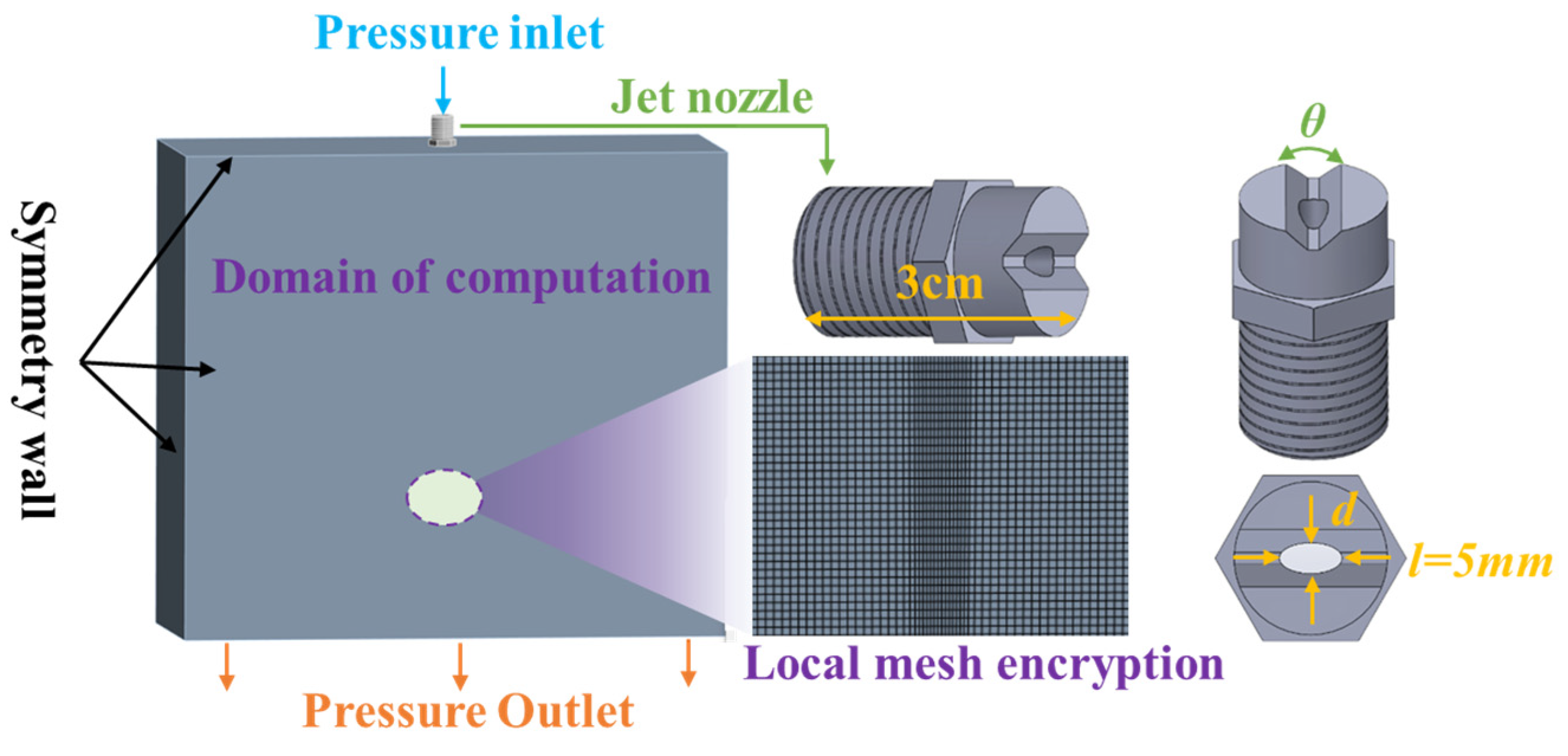
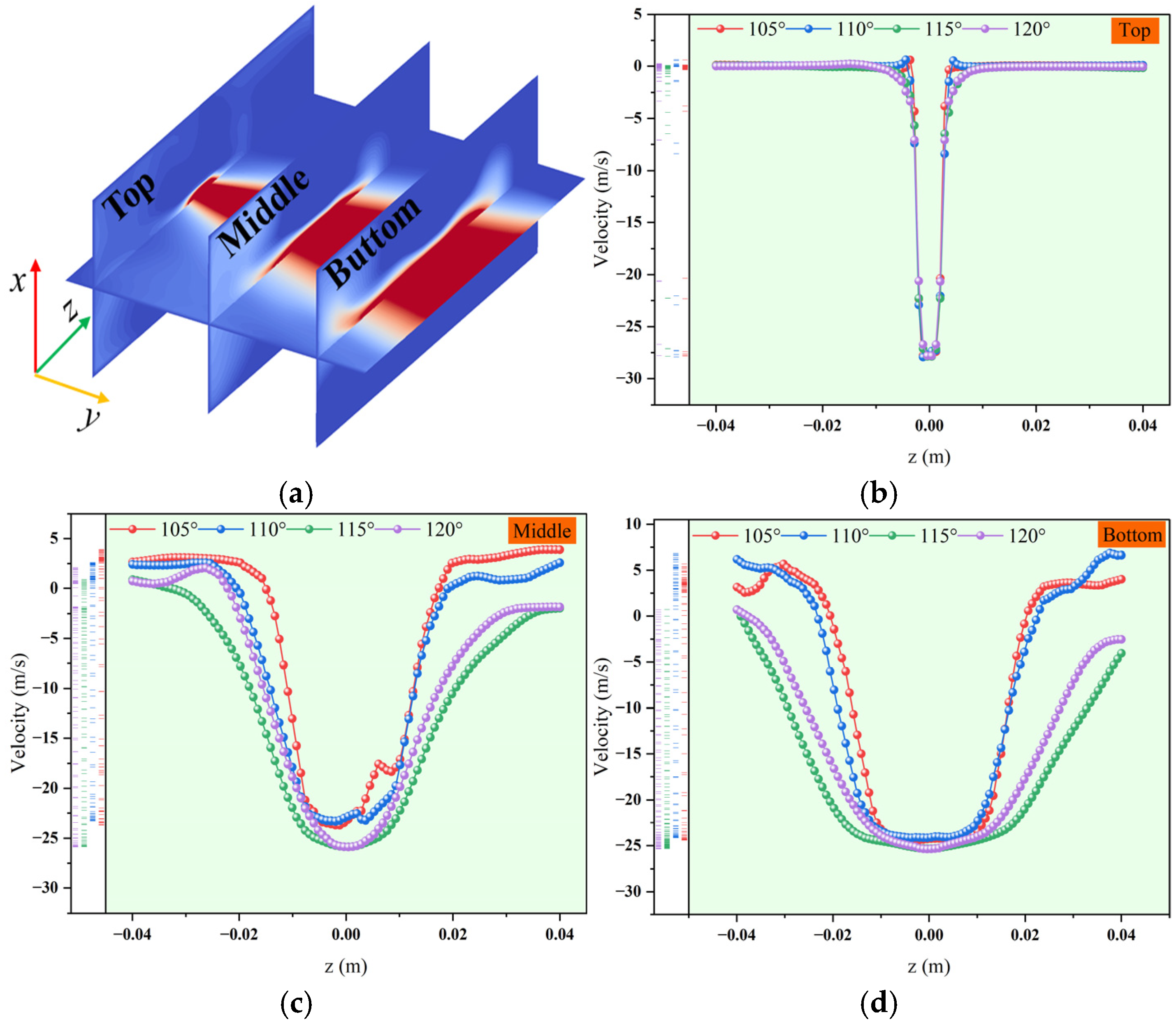
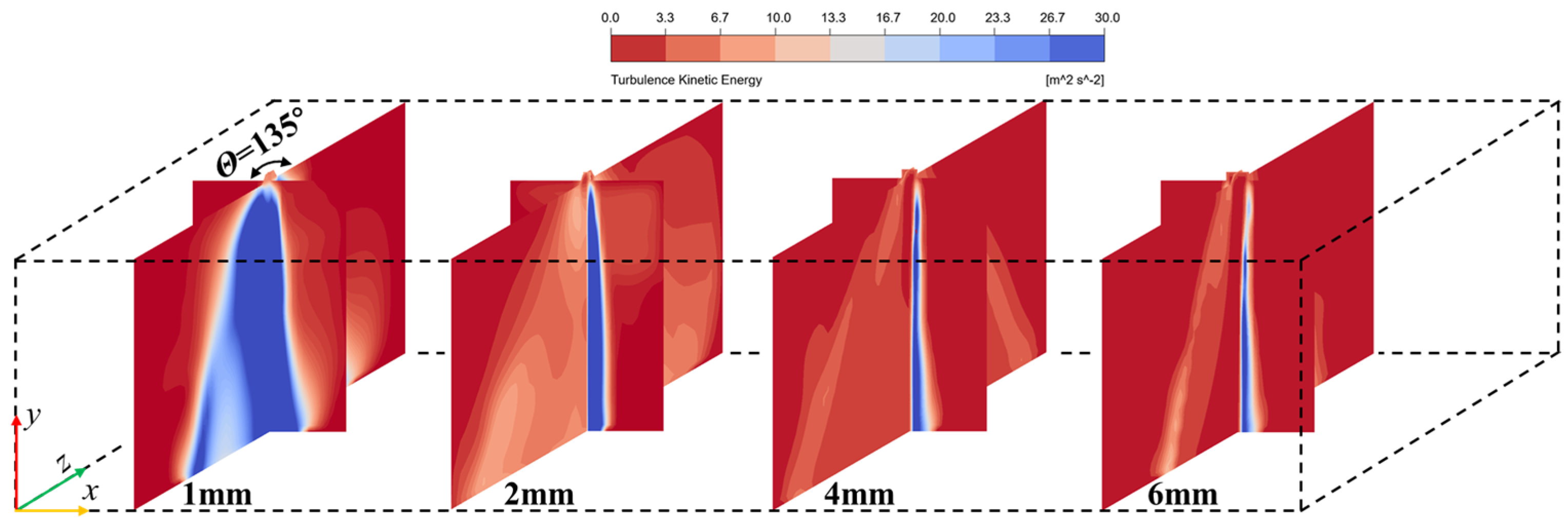
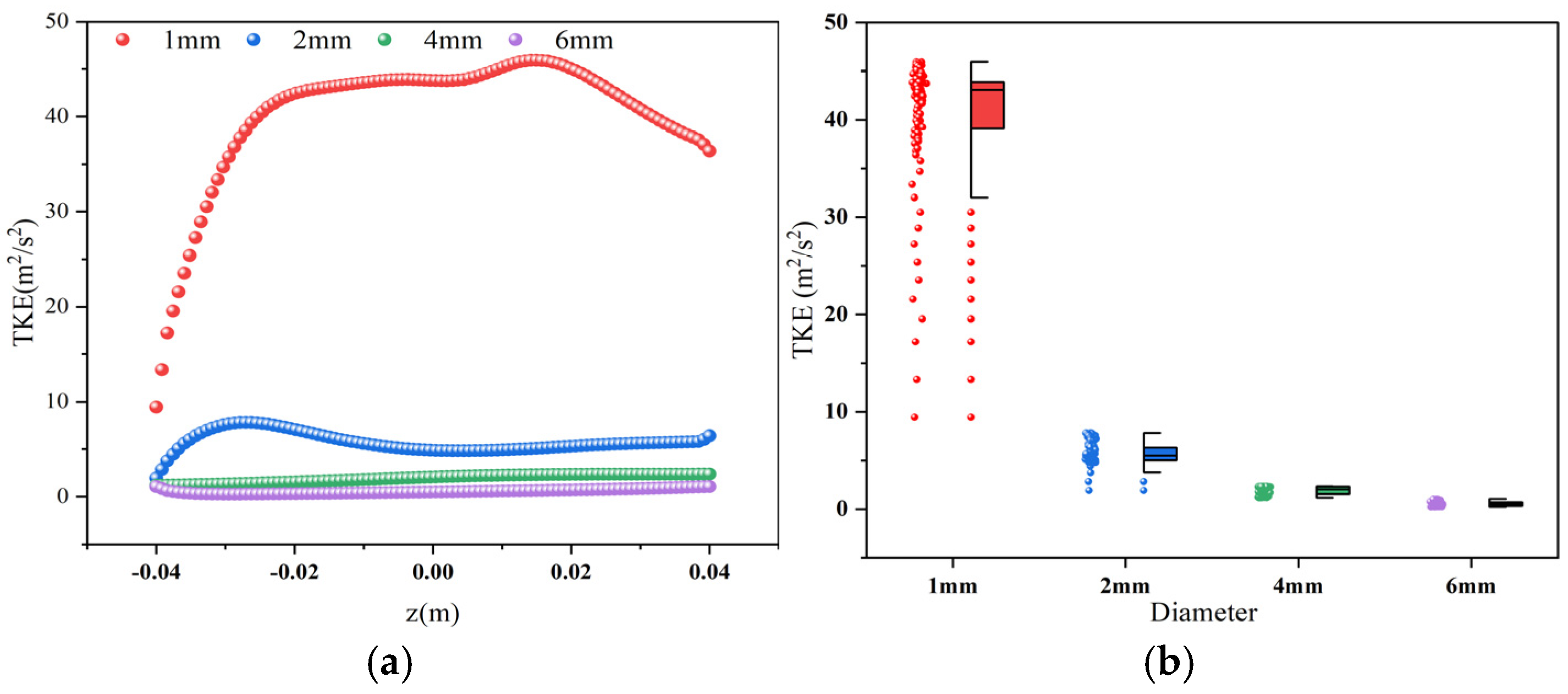
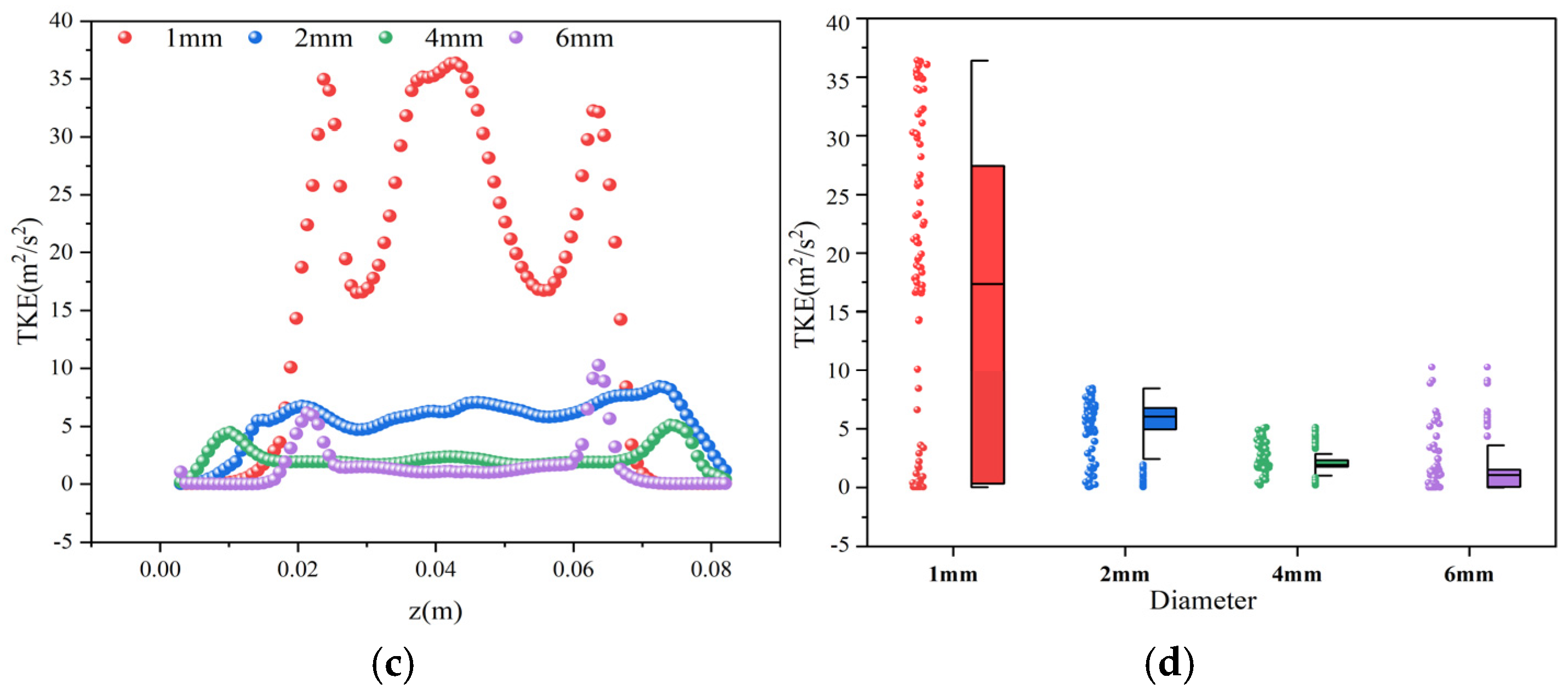
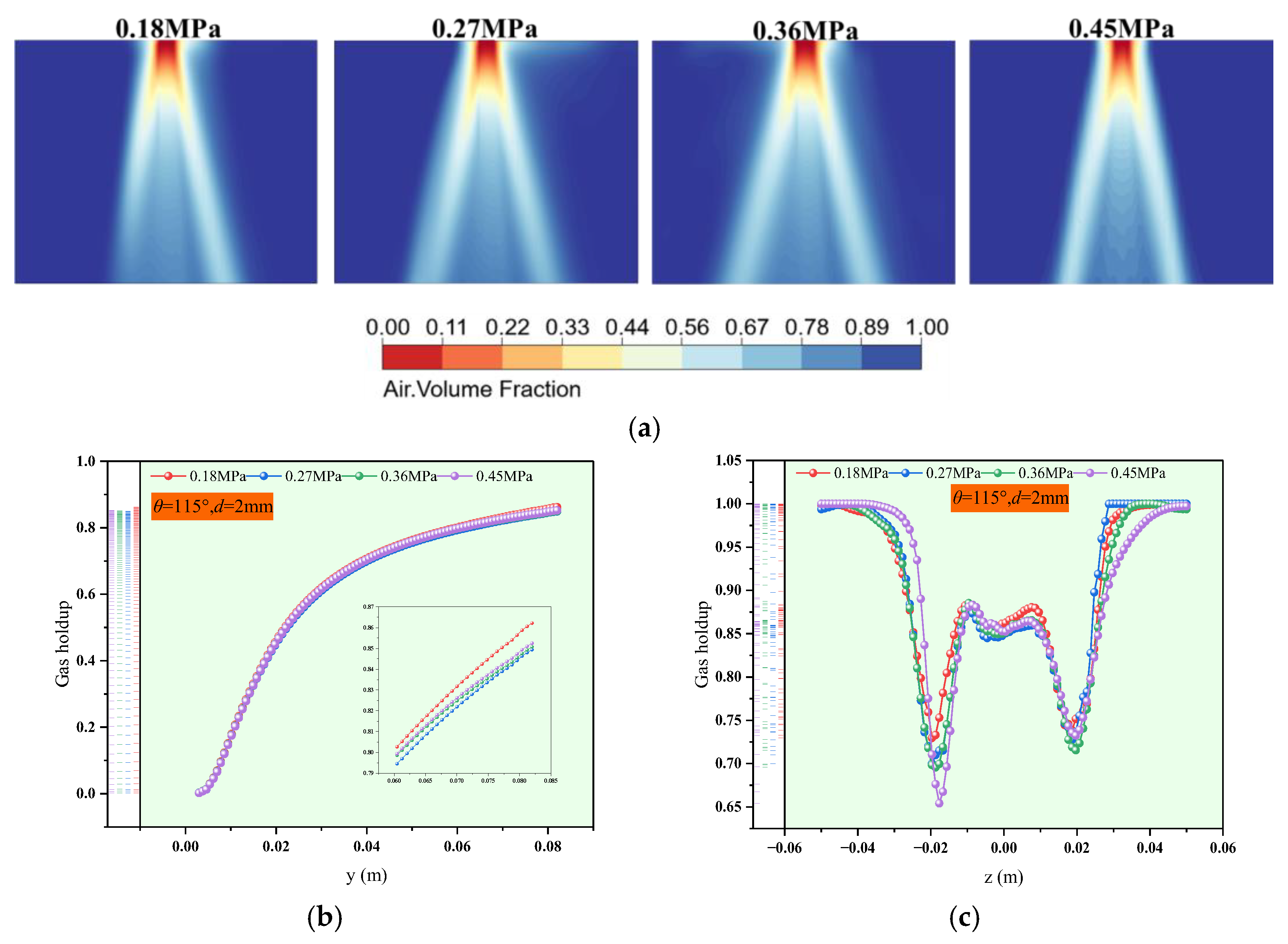
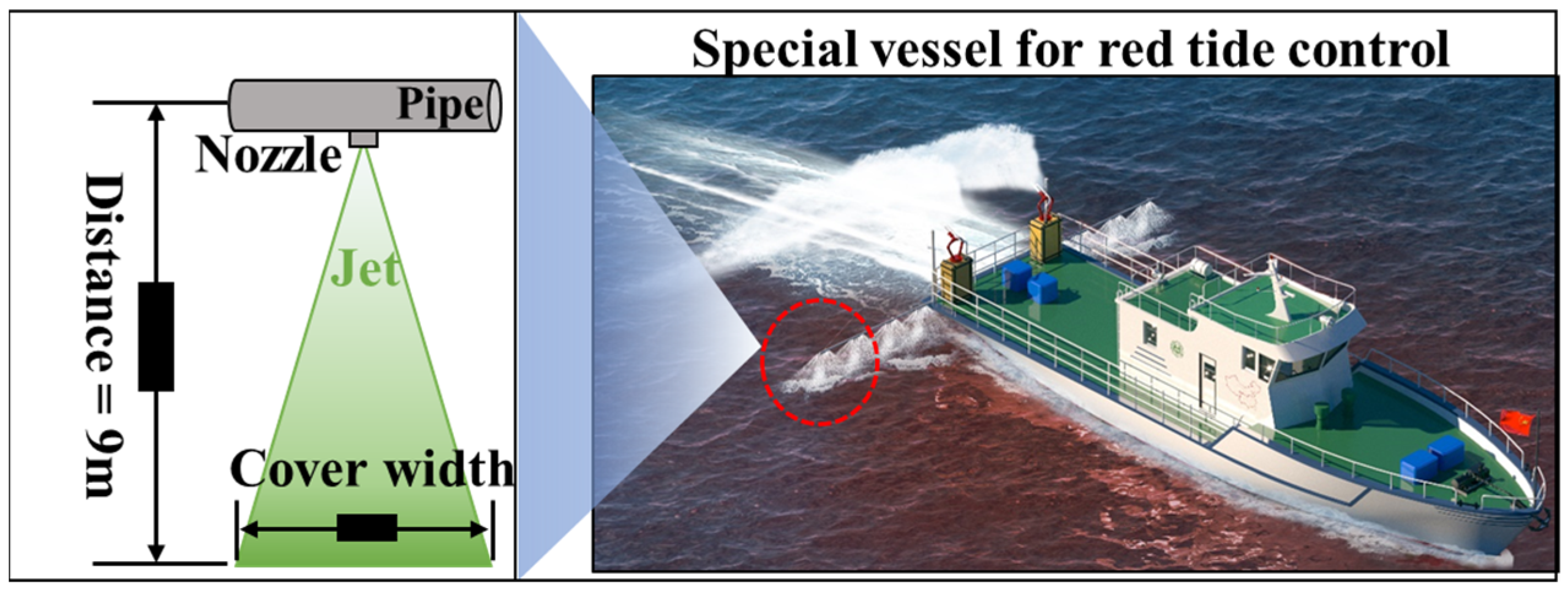

| No. | Initial Jet Flow Pressure (p/MPa) | Cone Angle (θ) | Nozzle Diameter (d/mm) |
|---|---|---|---|
| 1 | 0.36 | 105° | 2 |
| 2 | 0.36 | 110° | 2 |
| 3 | 0.36 | 115° | 2 |
| 4 | 0.36 | 120° | 2 |
| 5 | 0.36 | 115° | 1 |
| 6 | 0.36 | 115° | 2 |
| 7 | 0.36 | 115° | 4 |
| 8 | 0.36 | 115° | 6 |
| 9 | 0.18 | 115° | 2 |
| 10 | 0.27 | 115° | 2 |
| 11 | 0.36 | 115° | 2 |
| 12 | 0.48 | 115° | 2 |
| No. | Size of Grid (mm) | The Maximum Velocity (m/s) |
|---|---|---|
| 1 | 0.40 | 22.56 |
| 2 | 0.20 | 23.78 |
| 3 | 0.10 | 24.41 |
| 4 | 0.05 | 24.48 |
| No. | Initial Jet Flow Pressure (p/MPa) | Cone Angle (θ) | Nozzle Diameter (d/mm) | Equivalent Diameters (d/mm) |
|---|---|---|---|---|
| 1 | 0.36 | 105° | 2 | 39.3 |
| 2 | 0.36 | 110° | 2 | 45.1 |
| 3 | 0.36 | 115° | 2 | 54.8 |
| 4 | 0.36 | 120° | 2 | 46.9 |
| 5 | 0.36 | 115° | 1 | 41.2 |
| 6 | 0.36 | 115° | 4 | 42.8 |
| 7 | 0.36 | 115° | 6 | 40.6 |
| 8 | 0.18 | 115° | 2 | 46.7 |
| 9 | 0.27 | 115° | 2 | 49.1 |
| 10 | 0.48 | 115° | 2 | 47.1 |
Disclaimer/Publisher’s Note: The statements, opinions and data contained in all publications are solely those of the individual author(s) and contributor(s) and not of MDPI and/or the editor(s). MDPI and/or the editor(s) disclaim responsibility for any injury to people or property resulting from any ideas, methods, instructions or products referred to in the content. |
© 2024 by the authors. Licensee MDPI, Basel, Switzerland. This article is an open access article distributed under the terms and conditions of the Creative Commons Attribution (CC BY) license (https://creativecommons.org/licenses/by/4.0/).
Share and Cite
Zhang, B.; Zhu, C.; Li, J.; Wang, H.; Liu, X.; Wang, K. Optimization Study on Nozzle Selection Based on the Influence of Nozzle Parameters on Jet Flow Field Structure. Appl. Sci. 2024, 14, 9098. https://doi.org/10.3390/app14199098
Zhang B, Zhu C, Li J, Wang H, Liu X, Wang K. Optimization Study on Nozzle Selection Based on the Influence of Nozzle Parameters on Jet Flow Field Structure. Applied Sciences. 2024; 14(19):9098. https://doi.org/10.3390/app14199098
Chicago/Turabian StyleZhang, Bin, Chencheng Zhu, Jianxun Li, Hao Wang, Xiaolei Liu, and Kan Wang. 2024. "Optimization Study on Nozzle Selection Based on the Influence of Nozzle Parameters on Jet Flow Field Structure" Applied Sciences 14, no. 19: 9098. https://doi.org/10.3390/app14199098






